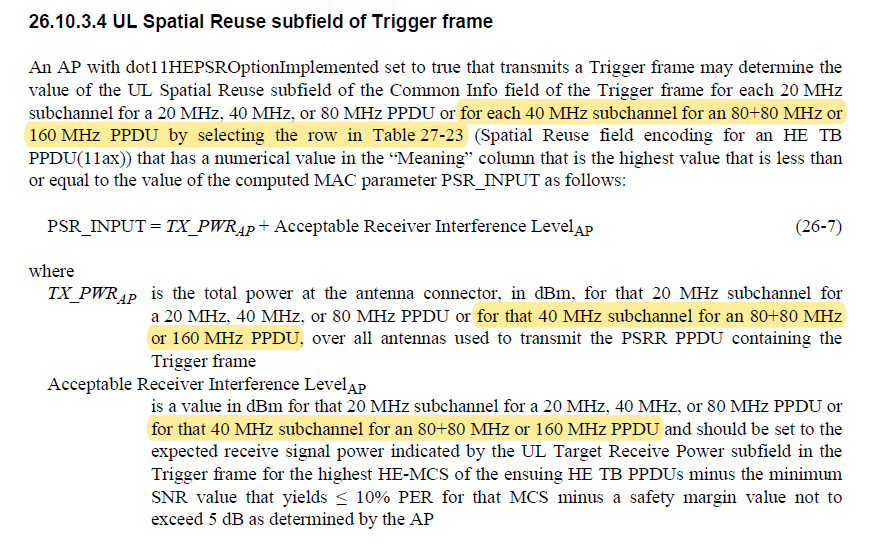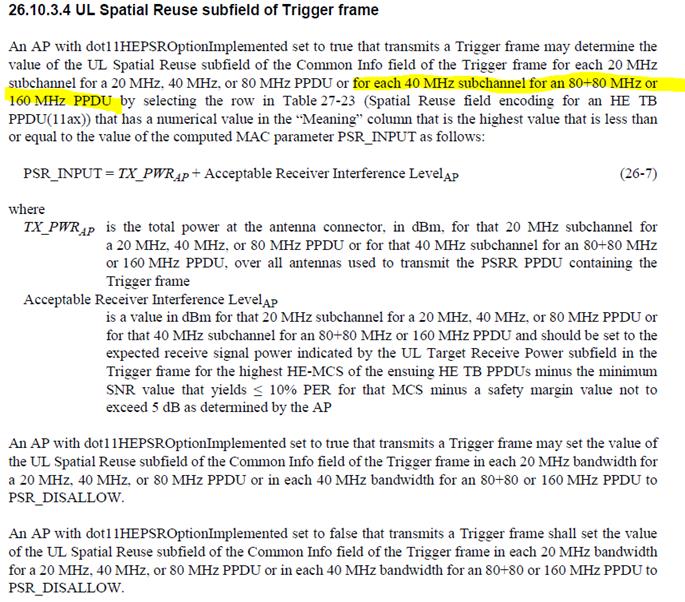Hi Youhan,
I have the different understanding about the UL Spatial Reuse subfield of Trigger frame. Below is the text from REVmeD1.0. It clearly indicates that “the UL Spatial Reuse subfield of the Common Info field of the Trigger frame …
for each 40 MHz subchannel for an 80+80 MHz or 160 MHz by selecting the row in Table 27-23….” The definitions of Tx_PWR_AP and Acceptable receiver Interference Level_AP consistently follow the definition
of the UL Spatial Reuse subfield. Nothing in the texts specifies the unit of PSR is per 20 MHz.

Thanks,
Zinan
From: Youhan Kim <youhank@xxxxxxxxxxxxxxxx>
Sent: Tuesday, May 10, 2022 1:58 PM
To: STDS-802-11@xxxxxxxxxxxxxxxxx
Subject: Re: [STDS-802-11] 11-22/0652
--- This message came from the IEEE 802.11 Working Group Reflector ---
Hi, Zinan.
Regarding #2 in your first email in this thread,
|
As indicated in
26.10.3.4 (P4242L1, REVme D1.0), UL Spatial Reuse subfield of Trigger frame is defined for each 40 MHz subchannel for an 80+80MHz or 160 MHz PPDU. The Spatial Reuse subfields of HE-SIG-A field of an HE TB PPDU should follow this definition, i.e., Spatial
Reuse value is applied to 40MHz subband of the 160MHz band. Therefore, when the PSRR PPDU is 160MHz, to get PSR for 20 MHz subchannel, it needs to normalize the PSR value of the UL Spatial Reuse subfield in the Common Info field of the Trigger frame of the
PSRR PPDU to 20 MHz subchannel. The NOTE in the 11-22/0652r3 explained this already. |
our understanding is that the PSR value is still in units of “/20 MHz” even for 160 and 80+80 MHz HE PPDUs. It is just that the lowest two 20 MHz (40 MHz in total) share the same PSR value (which is
in units of “/20MHz”), and the next two 20 MHz share the same PSR value, etc.
Hence, I suggest that in 11-22/652r3:
- “Each PSR value is specified per 20 MHz.”
à “Each PSR value has unit of X / 20 MHz.”
- We need to clarify what X is, which is CID 2240
- Delete the NOTE at the end of 11j-22/652r3.
Thanks.
Youhan
From: Youhan Kim <youhank@xxxxxxxxxxxxxxxx>
Sent: Tuesday, May 10, 2022 6:43 AM
To: ross.yujian@xxxxxxxxxx;
STDS-802-11@xxxxxxxxxxxxxxxxx
Subject: RE: 11-22/0652
Thanks, Zinan and Ross.
|
May I know if 802.11be or 802.11ax specs specifies “preamble of PSRR PPDU is present” is equivalent to the non-punctured subchannel(s) in PSRR PPDU? |
A punctured subchannel must not have any signal present, including any preamble.
Therefore, if there is preamble present in a 20 MHz channel, then that 20 MHz channel cannot be a punctured subchannel.
Therefore, I would like to have the following update on the text:
|
As you pointed out, it is not practical to assume that a STA would know which 20 MHz channel(s) would be used for PSRT PPDU transmission while receiving a PSRR PPDU.
That is why my proposed text said “at least one 20 MHz subchannel in which the preamble of both the PSRR PPDU and the PSRT PPDU are present”. Since a STA would
transmit a PSRT PPDU using at least the primary 20 MHz channel included, a reasonable/practical implementation measuring the signal power of a PSRR PPDU at the primary 20 MHz channel of the STA would still be able to transmit the PSRT PPDU in this case.
In your proposed text, however, there is a “shall” requirement that the signal power of PSRR PPDU is measured over the subchannels used by the PSRT PPDU. I.e., your proposal actually requires that a STA knows
the PSRT PPDU BW when receiving a PSRR PPDU.
Hence, I prefer my proposed language.
Thanks.
Youhan
From: Yujian (Ross Yu) <00001792b51ef4ea-dmarc-request@xxxxxxxxxxxxxxxxx>
Sent: Wednesday, May 4, 2022 6:38 PM
To: STDS-802-11@xxxxxxxxxxxxxxxxx
Subject: [STDS-802-11] 答复: 11-22/0652
WARNING:
This email originated from outside of Qualcomm. Please be wary of any links or attachments, and do not enable macros.
--- This message came from the IEEE 802.11 Working Group Reflector ---
Hi Zinan,
Thanks for the contribution and update. Both your version and Youhan’s version look good to me.
regards
于健 Ross Jian Yu
Huawei Technologies
发件人: Zinan Lin [mailto:000019c80da359b9-dmarc-request@xxxxxxxxxxxxxxxxx]
发送时间: 2022年5月4日 10:07
收件人:
STDS-802-11@xxxxxxxxxxxxxxxxx
主题: Re: [STDS-802-11] 11-22/0652
--- This message came from the IEEE 802.11 Working Group Reflector ---
Youhan,
Thanks for your suggestions. I have a few in line comments
on your suggestions.
Best,
Zinan
From: Youhan Kim <youhank@xxxxxxxxxxxxxxxx>
Sent: Tuesday, May 3, 2022 1:49 AM
To: STDS-802-11@xxxxxxxxxxxxxxxxx; Zinan Lin <Zinan.Lin@xxxxxxxxxxxxxxxx>;
ross.yujian@xxxxxxxxxx
Subject: RE: 11-22/0652
Hi, Zinan.
Thank you very much for the document.
RPLPSRR,20MHz
is the received signal power at the receive antenna connector in the nonpunctured 20 MHz subchannel in dBm. It can be the received signal power at the received antenna connector
in at least one nonpunctured 20 MHz subchannel within the overlapping bandwidth of the PSRR PPDU and the PSRT PPDU, or the received signal power at the received antenna connector in the nonpunctured 20 MHz subchannels within the overlapping bandwidth of the
PSRR PPDU and the PSRT PPDU normalized to a 20 MHz subchannel. The identification of the overlapping bandwidth is implementation dependent. |
The most important thing is to be clear that the unit of RPL_{PSRR,20MHz} is dBm/20MHz. How one computes it is implementation specific, except that I agree with you that 20 MHz subchannels which are used in both the PSRR and PSRT should
be used. Therefore, my suggestion is
|
RPLPSRR,20MHz
is the received signal power at the |
[ZL]
- May I know if 802.11be or 802.11ax specs specifies “preamble of PSRR PPDU is present” is equivalent to the non-punctured subchannel(s) in PSRR PPDU?
- I am concerned about requiring the preamble presence in both PSRR PPDU and PSRT PPDU. Since the formula is used to set the upper bound of PSRT PPDU transmission power, how can the PSRT PPDU
be present when the measurement is made prior to the first transmission?
Therefore, I would like to have the following update on the text:

I still need more time to review your #2.
Regards,
Youhan
From: Zinan Lin <Zinan.Lin@xxxxxxxxxxxxxxxx>
Sent: Monday, May 2, 2022 11:09 AM
To: Youhan Kim <youhank@xxxxxxxxxxxxxxxx>;
ross.yujian@xxxxxxxxxx
Cc: STDS-802-11@xxxxxxxxxxxxxxxxx
Subject: FW: 11-22/0652
WARNING:
This email originated from outside of Qualcomm. Please be wary of any links or attachments, and do not enable macros.
Hi Youhan and Ross,
Per the requirement of REVme minutes (11-22/0679r0), I am resending the discussion email to the reflector.
Thanks,
Zinan
From: Zinan Lin
Sent: Friday, April 29, 2022 10:55 AM
To: youhank@xxxxxxxxxxxxxxxx; Yujian (Ross Yu) <ross.yujian@xxxxxxxxxx>
Cc: Rui Yang <Rui.Yang@xxxxxxxxxxxxxxxx>; M Montemurro <montemurro.michael@xxxxxxxxx>
Subject: 11-22/0652
Hi Youhan and Ross,
Thanks for your comments and discussions on 11-22/0652!
Attached please find the updated document. I summarize the resolutions for the comments you made:
- The definition ofRPLPSRR,20MHz
is updated as follows:
RPLPSRR,20MHz
is the received signal power at the receive antenna connector in the nonpunctured 20 MHz subchannel in dBm. It can be the received signal power at the received antenna connector
in at least one nonpunctured 20 MHz subchannel within the overlapping bandwidth of the PSRR PPDU and the PSRT PPDU, or the received signal power at the received antenna connector in the nonpunctured 20 MHz subchannels within the overlapping bandwidth of the
PSRR PPDU and the PSRT PPDU normalized to a 20 MHz subchannel. The identification of the overlapping bandwidth is implementation dependent.
- As indicated in
26.10.3.4 (P4242L1, REVme D1.0), UL Spatial Reuse subfield of Trigger frame is defined for each 40 MHz subchannel for an 80+80MHz or 160 MHz PPDU. The Spatial Reuse subfields of HE-SIG-A field of an HE TB PPDU should follow this definition, i.e., Spatial
Reuse value is applied to 40MHz subband of the 160MHz band. Therefore, when the PSRR PPDU is 160MHz, to get PSR for 20 MHz subchannel, it needs to normalize the PSR value of the UL Spatial Reuse subfield in the Common Info field of the Trigger frame of the
PSRR PPDU to 20 MHz subchannel. The NOTE in the 11-22/0652r3 explained this already.

Please let me know your comments.
Thanks,
Zinan
To unsubscribe from the STDS-802-11 list, click the following link:
https://listserv.ieee.org/cgi-bin/wa?SUBED1=STDS-802-11&A=1
To unsubscribe from the STDS-802-11 list, click the following link:
https://listserv.ieee.org/cgi-bin/wa?SUBED1=STDS-802-11&A=1
To unsubscribe from the STDS-802-11 list, click the following link:
https://listserv.ieee.org/cgi-bin/wa?SUBED1=STDS-802-11&A=1
To unsubscribe from the STDS-802-11 list, click the following link: https://listserv.ieee.org/cgi-bin/wa?SUBED1=STDS-802-11&A=1